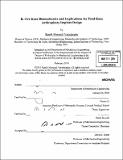In vivo knee biomechanics and implications for total knee arthroplasty implant design
Author(s)
Mangudi Varadarajan, Kartik, 1981-
DownloadFull printable version (16.20Mb)
Other Contributors
Massachusetts Institute of Technology. Dept. of Mechanical Engineering.
Advisor
Guoan Li.
Terms of use
Metadata
Show full item recordAbstract
The overall objective of this thesis was to determine the limitations of contemporary Total Knee Arthroplasty (TKA) and to identify areas for future improvements. In line with this objective, the first goal was to quantify the ability of current TKA systems to restore normal knee kinematics and anatomy. Recently, proposals for gender specific TKA have generated much controversy, with little scientific information being available to support or refute the need for such implants. Therefore, a second goal of this thesis was to investigate similarities and differences between male and female knee kinematics and anatomy, to determine if significant benefits can be obtained by incorporating gender specific variations into TKA designs. With regards to the first objective, significant differences were noted between the trochlear groove geometry of standard TKA implant and the normal knee, which could lead to non-physiologic patellar tracking post-TKA. Additionally, following TKA the knee joints were overstuffed in flexion, which may in part be responsible for limited post-operative range of knee flexion. Finally, standard TKA did not restore the kinematics of osteoarthritic knees towards normal, and normal kinematics patterns such as posterior femoral translation and internal tibial rotation were substantially reduced after TKA. With regards to gender differences, majority of the tibiofemoral and all patellofemoral kinematic parameters were similar between male and female knees. However, females had more externally rotated tibia in early flexion and greater range of tibial rotation. This difference was also associated with a more medially oriented patellar tendon in the coronal plane and more externally twisted patellar tendon in the transverse plane, in females. Regarding knee anatomy, the only gender difference was the narrower width of the femoral sulcus and lateral femoral condyle in females. Thus, compared to differences between current TKA and the average normal knee, these gender differences were relatively subtle. Therefore, the focus for future TKA designs should be restoring the average normal knee biomechanics. Additionally, a greater range of implant sizes may be desirable to accommodate morphological variations in the widths of male and female knees.
Description
Thesis (Ph. D.)--Massachusetts Institute of Technology, Dept. of Mechanical Engineering, 2010. Cataloged from PDF version of thesis. Includes bibliographical references.
Date issued
2010Department
Massachusetts Institute of Technology. Department of Mechanical EngineeringPublisher
Massachusetts Institute of Technology
Keywords
Mechanical Engineering.